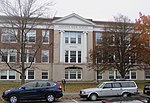WTSL
1950 establishments in New HampshireAdult hits radio stations in the United StatesHanover, New HampshireRadio stations established in 1950Radio stations in New Hampshire ... and 1 more
Use mdy dates from July 2023
WTSL (1400 AM) is a commercial radio station licensed to Hanover, New Hampshire, United States. It airs an adult hits radio format and serves the Lebanon-Hanover-White River Junction area. The station is owned by Great Eastern Radio, LLC. WTSL also broadcasts Dartmouth College Big Green football and hockey games. Listeners can also hear WTSL programming on FM translator stations W248DA at 97.5 MHz in Hanover and W269DI at 101.7 in Claremont, as well as on the second HD subchannel of WHDQ. The stations call themselves "97.5 & 101.7 The Penguin".
Excerpt from the Wikipedia article WTSL (License: CC BY-SA 3.0, Authors).WTSL
Richardson Place, Lebanon
Geographical coordinates (GPS) Address Nearby Places Show on map
Geographical coordinates (GPS)
| Latitude | Longitude |
|---|---|
| N 43.684238888889 ° | E -72.295647222222 ° |
Address
WTSL-AM (Hanover)
Richardson Place
03784 Lebanon
New Hampshire, United States
Open on Google Maps








